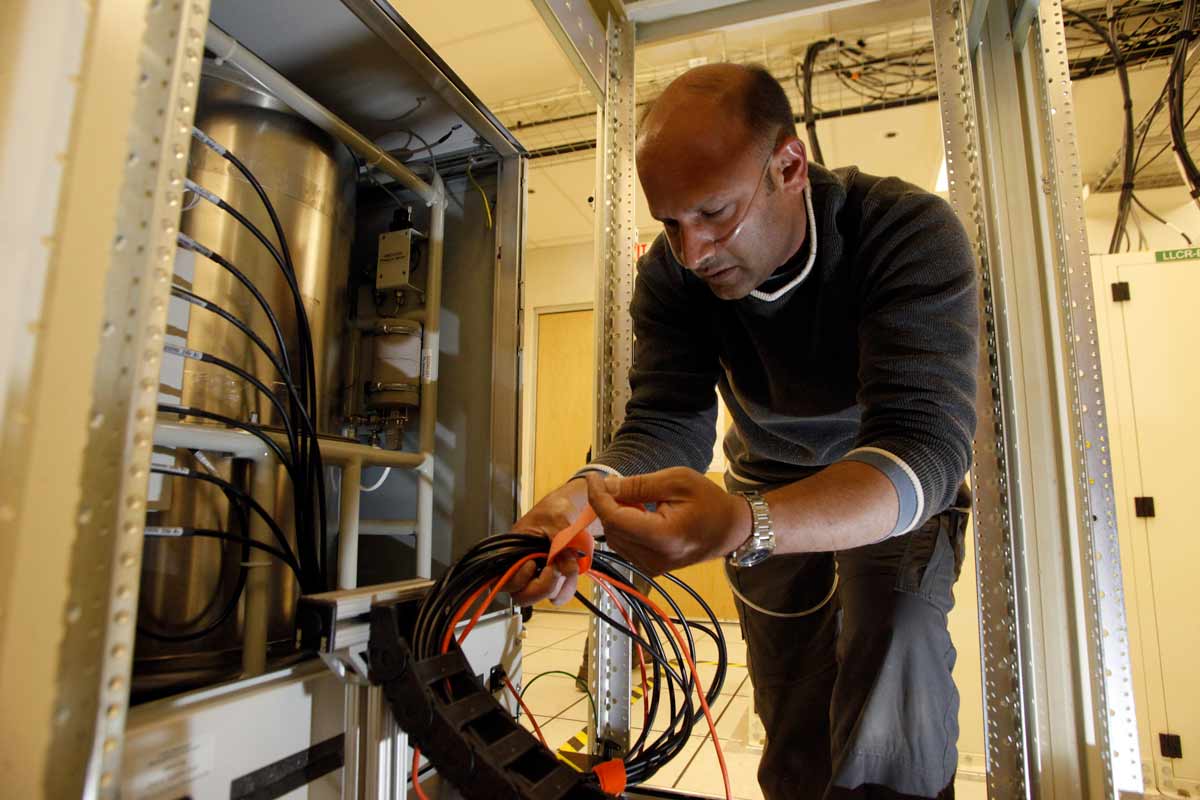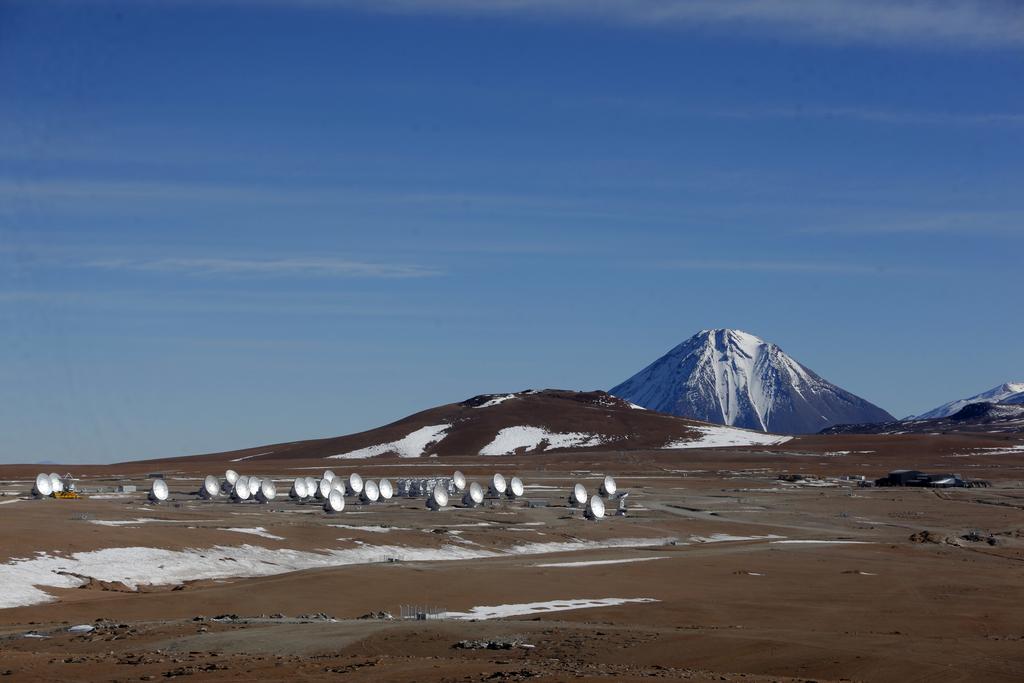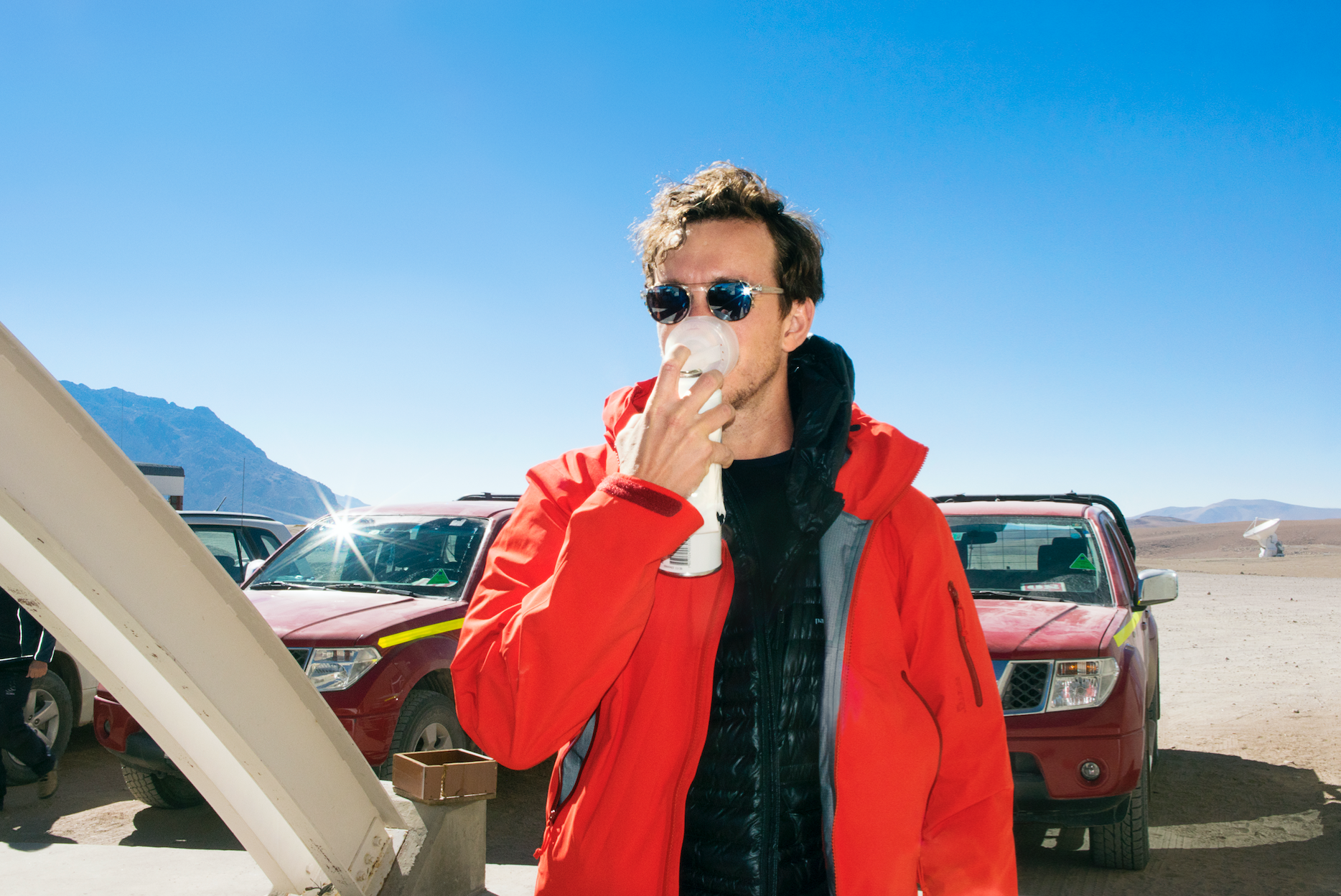We were perched dizzyingly high in the Chilean Andes, ringed by a herd of sixty-six white giants. Through the broad windows of the low, nondescript building in which we stood, we could see massive white radio antennas outside against the Martian-red soil of the desolate Chajnantor Plateau, their dishes thrust towards a pure blue sky.
This is the Atacama Large Millimeter Array, also known as ALMA—one of the world’s largest radio telescope arrays, an international partnership that spans four continents. In spring of 2017, ALMA, along with eight other telescopes around the world, will aim towards the center of the Milky Way, around 25,000 light years from Earth, in an attempt to capture the first-ever image of a black hole. This is part of a daring astronomy project called the Event Horizon Telescope (EHT).
Videos by VICE

Areal picture of the Array Operations Site. Image: W. Garnier/ALMA (ESO/NAOJ/NRAO)
My partner Dave Robertson and I took turns huffing from a can of oxygen to stave off the altitude sickness that can come on at 16,500 feet. Our guide Danilo Vidal, an energetic Chilean who wore his dark hair in a ponytail, pointed to a grey metal door with a glass window. “If we open that door,” said Vidal, “everyone in science will hate us for the rest of our lives.” Confused by this cryptic statement, I took another hit from the oxygen and peered through the glass, into the heart of the experiment.
Among a small forest of processors, I could see an eggshell-white box that resembled a dorm room refrigerator. Inside was the brand-new maser, an ultraprecise atomic clock that syncs up every antenna on-site, and then syncs ALMA itself to the Event Horizon Telescope’s global network, lending so much dish-space and processing power that it effectively doubles the entire network’s resolution.

Christophe Jacques of the NRAO inspects the wiring on ALMA’s new hydrogen maser atomic clock during installation. Image: Carlos Padilla/NRAO/AUI/NSF
To keep equipment from overheating, the room is kept at an absurdly low temperature—very close to absolute zero. If we opened the door, Vidal explained, emergency systems would instantly shut down the maser to protect it, and ALMA’s beating heart would stop, ruining multiple international astronomy projects, including the EHT.
Claudio Follert, an ALMA fiber-optic specialist in his mid-fifties, was there in 2014 when the maser first arrived—he told me it was a machine he had never seen before, carried in by strange men. The men were sent by the EHT, which is based out of MIT.
The EHT is made possible by the maser’s astonishing precision—about one billion times more precise than the clock in your smartphone.

Chajnantor Plateau. Image: Carlos Padilla/ALMA (ESO/NAOJ/NRAO)
Designed by an international team led by MIT scientist Shep Doeleman, the EHT is the first of its kind-a global telescope network that uses a technique called interferometry to synthesize astronomical data from multiple sources, each with its own maser—including ALMA in Chile, the Large Millimeter Telescope atop the Sierra Negra volcano in Mexico, and the National Radio Astronomy Observatory in Virginia.
Together, these telescopes create a super-telescope that is quite literally the size of the Earth, with enough resolution to photograph an orange on the Moon.
With ALMA recently added to this Avengers-like team of radio telescopes, the network is ten times more sensitive. As a result, Doeleman’s group believes it has the firepower to penetrate the interstellar gases that cloak their targets: supermassive black holes. Drawn into orbit by the black holes’ gravity, these gases form gargantuan clouds that yield nothing to optical telescopes.
Faint radio signals from the black holes, on the other hand, slip through the gas clouds and are ultimately detected on Earth.
*
Black holes are the folk legends of outer space. Since no light can escape them, they’re invisible to the eye, and we have no confirmation that they actually exist—only heaps of indirect evidence, particularly the gravitational wobbles in orbits of nearby stars, the behavior of interstellar gas clouds, and the gaseous jets that spew into space when an unseen source of extreme gravity appears to rip cosmic matter to shreds.
Black holes challenge our most fundamental beliefs about reality. Visionary scientific minds, including the theoretical physicists Stephen Hawking and Kip Thorne, have devoted entire books to unpacking the hallucinatory scenarios thought to be induced by black holes’ gravitational forces—imagine the bottom of your body violently wrenched away from the top, physically stretching you like a Looney Tunes character, a scenario that Thorne’s Black Holes and Time Warps paints in stomach-churning detail.

An image from the heart of the Milky Way from NASA’s Chandra X-ray Observatory. The supermassive black hole is at the center. Image: NASA/CXC/MIT/F. Baganoff et al.
Black holes are thought to lurk at the centers of galaxies including our own. Prove the existence of Sagittarius A*, the supermassive black hole at the heart of the Milky Way, and you are one step closer to solving another mystery: the origin of humankind, and all life as we know it.
“The black hole at the center of our galaxy has everything to do with our own origin,” said Violette Impellizzeri, an ALMA astronomer collaborating with Event Horizon Telescope. Supermassive black holes are thought to regulate the stars that surround them, influencing their formation and orbit. “Understanding how our galaxy was formed leads to our own origin directly,” she said.
Read More: A New Search Technique Could Exponentially Boost Discoveries of Black Holes
Scientists estimate the mass of Sagittarius A* to be four million times that of our Sun, yet its diameter is roughly equal to the distance from our sun to Mercury—not much, in cosmic terms. The resulting density produces gravity so strong that space and time distort around it, making it invisible.
The current theory, espoused by Thorne, is that the distance from the center of a black hole, known as the singularity, to its edge, known as the event horizon, becomes so warped that it nears infinite length, and light simply runs out of energy as it tries to escape.
It took Doeleman, the project leader at MIT, to decide that in order to see the unseeable, you would first have to create a new kind of vision. With ALMA as part of the giant EHT network, we can take a radio “photograph” of the matter that orbits Sagittarius A*—called the accretion disk—and finally see the black hole in shadow: its first-ever portrait.
*
Vidal and Follert, the guide and fiber-optic specialist, led us out onto the plateaus. There was work to do: one of the antennas was hobbled by a damaged radio receptor.
It was blindingly bright and windy, not to mention dry—Chajnantor is located in Chile’s Atacama Desert, the driest place on Earth, if you don’t count the poles. Completely inhospitable for human beings, Chajnantor is an ideal setting for a radio telescope: the elevation puts it closer to the stars, and the strikingly low water vapor keeps the cosmic signals pristine.

ALMA PR coordinator Danilo Vidal and William Rauscher on Chajnantor, where it’s almost always sunny, exceptionally windy, and difficult to breathe. Image: Dave Robertson
For some, like ALMA’s crew, as well as Doeleman, the extreme environment is part of the attraction. “I just love getting to the telescopes,” he said. At 50, Doeleman is fresh-faced, with glasses and thinning hair that make him look every part the bookish scientist. His outgoing personality and entrepreneurial vigor reflect an explorer’s spirit more at home in the field than behind a desk.
Doeleman regularly travels to each EHT site around the world, many of them located in extreme environments like the Andes or the Sierra Negra. “The adventure part is what motivates me—driving along dirt roads, up the sides of mountains, to install new instruments, doing observations that have never been done before. It’s a little bit like Jacques Cousteau—we’re not sitting in armchairs in our offices.”
Outside on Chajnantor, I felt light-headed. I tried to keep my breathing steady: low oxygen can quickly wreck your mental faculties. On the plateau, Dave and I were dwarfed by ALMA’s antennas, which blocked out the desert sun. They felt powerful and eerie, like Easter Island statues. Even when standing directly beneath these behemoths, it wasn’t clear how they were controlled—the white dishes seemed to twist and pivot without warning.

Using a technique called interferometry, ALMA’s antennas can be configured to act as one giant antenna, and ALMA itself can be synced up with telescopes worldwide. Image: Dave Robertson
An ALMA antenna is useless when one of its radio receptors is out of tune. We followed Follert up several steel ladders, boots clanging on metal, until we were in a low-ceilinged maintenance room inside one of the antennas. We helped him remove the damaged receptor, a long metal cylinder resembling a futuristic bazooka.
Vidal drove us back down the mountain to the Operations Support Facility (OSF), ALMA’s headquarters, so we could see the lab where receptors are maintained.
Per strict international regulations, Vidal was required to breathe through an oxygen tube as he drove, lest the high altitude cause him to lose consciousness behind the wheel.
As we descended, Vidal radioed at regular intervals to identify our location. All around us the mountain slopes were red, rocky and barren—no wonder that NASA regularly deploys expeditions to this desert to replicate conditions on Mars.

On the plateau at 16,500 ft, roughly the elevation of Everest base camp, writer William Rauscher inhales oxygen to stave off altitude sickness. Image: Dave Robertson
Located at 9,000 ft, the OSF is where ALMA’s staff call home: a total of 600 scientists working in shifts are based here, including engineers and technicians, from over 20 countries. The working conditions can be extreme. Staff hole up in weeklong shifts separated from friends and family, and endure the short and long-term health risks of high elevation, including a stroke or pulmonary edema, where fluid fills your lungs and you suffocate.
It is thus maybe not surprising to find out that the entire staff are monitored regularly by medical personnel, and that emergency oxygen and a hyperbaric chamber are on-hand.
They unwind by exercising and watching movies, although certain sci-fi flicks are frowned upon. “We need a break from space sometimes,” said Follert. Alcohol consumption on site is strictly forbidden—have even a tipple and you risk amplifying the physical effects of high elevation.

Aerial picture of ALMA’s Operations Support Facility. Image: Carlos Padilla/NRAO/AUI/NSF
The close teamwork at ALMA is absolutely essential for the life of the observatory. Detecting cosmic radio signals, including those sent from a black hole, requires constant cooperation across teams, who must obsessively calibrate, maintain and repair their instruments to fend off unwanted noise.
ALMA and the other telescopes on the EHT will soon turn towards the center of the Milky Way to tune in to the black hole’s narrow radio frequency. The data that ALMA collects will be so large, it cannot be transferred online. Instead, physical hard drives will shipped by “sneakernet”: loaded into the belly of a 747 and flown directly to MIT.
When ALMA’s data is correlated with the other telescopes later this year, Sagittarius A* should appear against the glowing gas of the accretion disk. Maybe.
Actually, said Doeleman, “we don’t know what we’re going to see. Nature can be cruel. We may see something boring. But we’re not married to one outcome—we’re going to see nature the way nature is.”
Get six of our favorite Motherboard stories every day by signing up for our newsletter.




